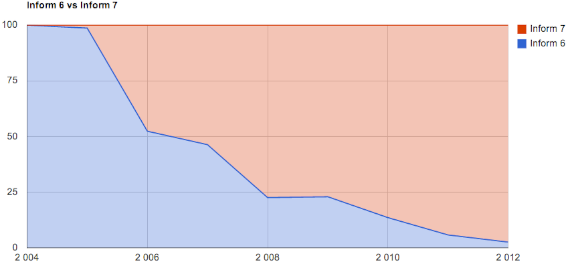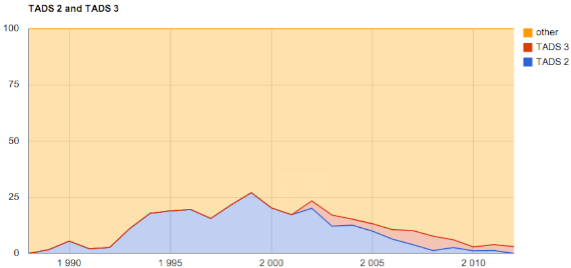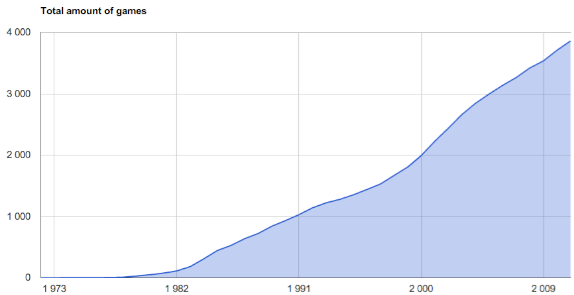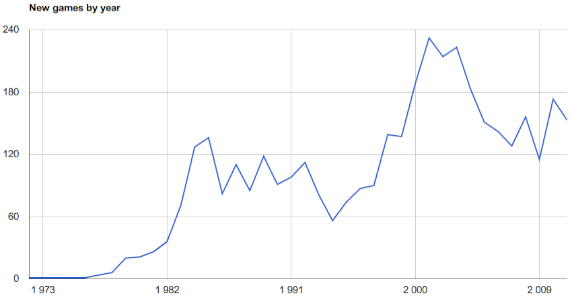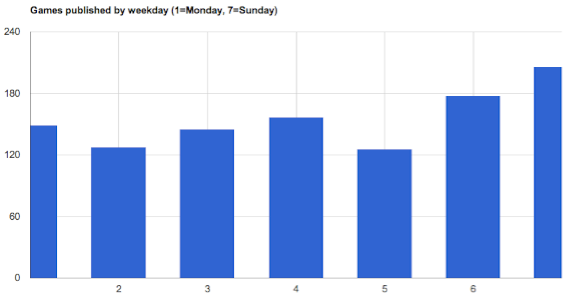The IFComp has just ended so it's a good time to compare historical IFComp results with scores given to games in IFDB. Are there any differences?
Continue reading "IFDB statistics, part 3: IFComp"
Statistics
IFDB statistics, part 2: Development systems
Click here to read all posts from the IFDB statistics series.
When we talk about development systems in IFDB, it's good to remember that some systems have better coverage than others. Parallel communities like Quest (201 games in its own site, 26 in IFDB), non-parser systems and the AIF crowd are underrepresented. Another factor that skews statistics is that game listings tend to display the system in which the game is available now—for example Scott Adams adventures are listed as Inform 6 games because the downloads are for the Inform ports.
In the all-time popularity chart Inform 6 is the clear leader: a quarter of all games have been made with it. Inform 6 and 7 together cover more than a third of all games.
The chart for current (2010-2012) systems is a bit different. Inform 7 has risen to dominate the field with the market share of two thirds. Inform 6 has dropped significantly and all other systems are in the margins. Does this mean that the field has become less diverse or that IFDB has not kept up with new systems?
The Commercial Era
I've split the statistics in two eras: the commercial era (before 1994) and the hobbyist era (from 1994 on). 1994 marks the beginning of a renaissance—IF died commercially but at the same time the publication of Inform practically created the modern hobbyist scene.
Many of the commercial era games don't have the system marked down or have a suspicious "none" (were they written directly into machine code?) or a vague "custom". The most popular system was Eamon, which was exclusively used to create stories in the Eamon game world. The Quill was almost as popular, although the Wikipedia article says there were more than 450 commercial The Quill games (203 listed in IFDB) which would make it more popular than Eamon.
The large number of Inform 6 games is because of ports, as mentioned above.
Looking at the numbers by year, Eamon reaches quickly its highest point in mid-80s and declines from there more or less steadily. The Quill and AGT have a more steady growth all the way to the 90s. As you might imagine, BASICs popularity drops quickly after dedicated development systems become available.
Here's the same chart but with percentages from the total number of games: the vertical thickness of the area denotes more games in relation to other systems, the full height being 100%. The data in this chart goes up to 1998 so that we see how all the "old" systems drop practically to zero in popularity by then.
The Hobbyist Era
In the mid-90s the playfield changes completely. TADS, Inform, ADRIFT and other systems are released and especially Inform gains popularity.
Inform's domination is apparent in the percentual view. TADS 2 has steady popularity until the turn of the millennium when it begins a downward slope. TADS 3 gains a small foothold but never grows very much. Hugo has seen a small resurrection lately, mostly thanks to a small but active group.
Inform
After Inform 6 was released, it rose to cover almost half of all published games in only two years. The same happened when Inform 7 was released: in a few years it took the lead, eating mostly Inform 6's popularity.
This year only a handful of Inform 6 games have been released and Inform is at almost 70%.
The question is: has Inform 7 attracted people into IF who would otherwise not have done so, or would people who now use Inform 7 started to use something else if it had never been released? Surely there are people in both groups, but the graph above suggests that Inform 7 is eating away the Inform 6 userbase, not others. The "everything else" line does not seem to have any correlation with the Inform 7 line.
TADS
TADS 2 was at its height in 1999 when 27% of all games were written using it. Another peak was in 2002 after TADS 3 was released, but since then their popularity has been on a steady downward curve.
Again, the statistics show no correlation between Inform and TADS. Peaks in Inform's popularity do not show anywhere in the TADS statistics. (You could argue that I7 might have cut short TADS 3's slow climb between 2004 and 2008, but I very much doubt it.)
IFDB statistics, part 1: Publishing date
Click here to read all posts from the IFDB statistics series.
A few months back Mike Roberts, the curator of IFDB, together with Andrew Plotkin released the full IFDB database dump. This is certainly a great deed, since the IFDB is the most complete source of information about IF to date and there's always a risk of data loss if the database is behind only one person. The database is an invaluable resource to (future) historians, researchers and people who love statistics.
And I do love statistics.
I've pulled a lot of interesting graphs from the database and will present them in a series of blog posts, of which this is the first one. We'll start slow by looking at the games' publishing dates and progress later to searching for more and more specific correlations.
It's worth noting that while IFDB has a lot of information, it's by no means comprehensive or 100% accurate. Therefore all this data reflects IFDB contents rather than the real world. How much the truth differs from the available data is open to discussion.
Click on the images to see the full data set, an interactive chart and chart display options. All available statistics can be seen collected on this page. More graphs are added as the series progresses.
You can also gladly suggest in the comments what kind of data you'd like to see analyzed.
Publishing date by year
There are 4173 games in the database, of which 4027 have a known publishing date. The graph for total number of games over time looks like this:
More informative is the number of games published each year:
You can see the "golden age" from mid-80s to early 90s, a small dip, and a steep rise starting soon after. I have no explanation for why there were so many releases in 2001–2003. In 2001 there were twice as many releases as in 2009.
In recent years the number of releases has varied between 115 (in 2009) and 173 (in 2010). There's no discernible trend to either direction and there's not enough data to make any predictions about the future. 2012 is not included in the graph but at the end of October there were 164 releases which is already more than in 2011 (153 releases).
Publishing month
This (and the next graph) is wildly inaccurate since about 70% of games have only the publishing year listed, not the exact date (which is why January 1st is excluded). Still, you see what you'd expect: IFComp games are released in October so it has the most releases and November is not a good time to release because the competition draws all the attention.
Publishing weekday
Games are released most often on Sunday and least often on Friday. Shouldn't be a surprise that weekends are the most common release days as most games are hobbyist efforts.
Next time we'll look at development system popularity.
Transcript recording plugin for Parchment released
As promised, the transcript recording plugin for Parchment has now been published. As the player is playing the game, the plugin sends the transcript to the server where it's saved to a database. The author can then later view the saved transcripts or use the information in the database to calculate statistics.
The plugin saves more than just plain text: it preserves text formatting and saves status lines as well, so the transcripts look (almost) the same as the actual game. (See this example of Bronze with status lines, colors and text formatting. Note that Parchment uses small caps in place of bold text.) The saved transcripts can be viewed with or without the status lines. In addition when the game waits for a single keypress, non-alphabet characters like enter, space and arrow keys are marked in the transcript.
There's a live demo with a transcript viewer available. Games played in the demo installation can be seen in the viewer.
The plugin and accompanying tools can be downloaded from Google Code where you'll also find installation instructions. Only Z-machine is supported at the moment, Glulx support will be added later.
Starborn statistics follow-up
Earlier I posted some statistics from transcripts collected from online plays of Starborn. Based on those statistics I released a new version at the end of January, mainly adding synonyms based on the most common typos players had made.
Looking at the data from before and after the update, here's what happened to the total amount of invalid commands:
Starborn: play statistics
Starborn is a short interactive sci-fi story that uses a simple keyword interface instead of a standard IF parser. It was made as a speed-if for this year's New Year's Speed-if event on ifMUD. It was released to the public about a week ago and at first gained the usual amount of interest: the logs show 7 online plays on the release day and less on the next two days.
Last Wednesday however C.E.J. Pacian wrote a blog post about it which was picked up by the IndieGames.com blog. From there a couple of people tweeted about it and suddenly the play count jumped to about 600 plays per day. The main Parchment site reported similar amounts of traffic.
I'm running the online version of the story on a modified version of Parchment that saves the transcripts to the server. I now have 1557 transcripts consisting of 23 896 turns (and counting, but the traffic is slowing down considerably). To my knowledge this is more play data collected than for any other single IF game so far.
So here's a random bunch of analysis from those transcripts. There are no spoilers other than keywords used throughout the game, but if you haven't played yet the data would probably make more sense if you at least checked out a couple of turns just to see what the parser looks like. Online version and downloads are available.
Collecting real life gameplay data with Parchment
There was a lot of talk during PAX East and elsewhere about collecting real life data from people playing IF. I'm proud to announce that I've hacked the Parchment web interpreter to do just this: it saves transcripts to the server every time a game is played.
Try it out yourself: Click here to start a game and then open this page to a new browser window. Enter a command in the game and see how the transcript in the live feed updates. (If you don't see your game in the live feed page, reload it. It shows the three latest games being played at the time the feed page was loaded.)
And then there's the beef: I've made a rudimentary statistics page that shows some interesting information using the collected data, including most used commands and average turn count and playtime.
Continue reading "Collecting real life gameplay data with Parchment"









